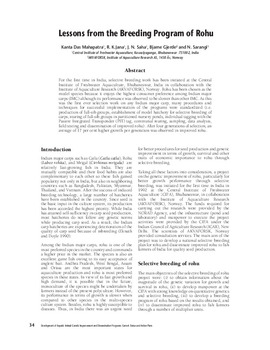Lessons from the breeding program of rohu

Citation
Mahapatra, K.D. et al. (2006). Lessons from the breeding program of rohu. p. 34-40. In: Ponzoni, R.W. ; Acosta, B.O. ; Ponniah, A.G. (eds.) Development of aquatic animal genetic improvement and dissemination programs: current status and action plans. WorldFish Center Conference Proceedings 73. Penang, Malaysia. 120 p.
For the first time in India, selective breeding work has been initiated at the Central Institute of Freshwater Aquaculture, Bhubaneswar, India in collaboration with the Institute of Aquaculture Research (AKVAFORSK), Norway. Rohu has been chosen as the model species because it enjoys the highest consumer preference among Indian major carps (IMC) although its performance was observed to be slower than other IMC. As this was the first ever selection work on any Indian major carp, many procedures and techniques for successful implementation of the programs were standardized (i.e. production of full-sib groups, establishment of model hatchery for selective breeding of carps, rearing of full-sib groups in partitioned nursery ponds, individual tagging with the Passive Integrated Transponder (PIT) tag, communal rearing, sampling, data analysis, field testing and dissemination of improved rohu). After four generations of selection, an average of 17 per cent higher growth per generation was observed in improved rohu.
Permalink
Date Available
Type
Publisher
Countries
Copyright
CC BY 4.0
Research Themes
Topics
Language